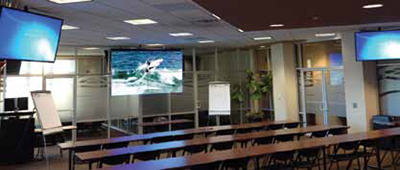United States educators are increasingly looking to advanced technology to deliver the curricular message. In this era of the smart phone, smart tablet, and smart everything, not to mention a multimedia hungry student body, schools are employing more sophisticated video and audio presentation systems to grab the eyes and ears of today’s technology-savvy students. Tiled, high-definition, LCD video walls are becoming the next wave of technology for the classroom. These systems deliver high-impact video presentations from a wide range of local and remote sources simultaneously, including computers, DVD players, media players, tablets, cable, internet and more. Video walls are commonly assembled into large two-by-two, three-by three, or larger configurations and are programmed to display one image across all the screens. LCD screens offer incredible resolution, which allows students to view subject matter in more detail.
One of the main considerations is, how will the video wall be used? Will the wall be simply a monitor that displays educational materials, or will the display need to be an interactive touch screen? The next important step is where will the video wall be installed? For instance, an interactive video wall will require that the screens be within easy reach of both students and faculty, however, it will need to be installed at a safe distance above the floor so that shoes, chairs, floor cleaning equipment, etc. will not damage the bottom row of screens.
A 500-seat lecture hall would typically need a video wall that is between 10- and 15-feet wide, depending upon its application, whereas a 1,500-seat facility may require a video wall twice that size. With the desired size of the video wall established, inspecting the structure around the installation site will be necessary to ensure that the existing classroom wall can support the weight of the proposed video wall. An approximate weight of the video wall installed in the above 500-seat lecture hall could weigh as much as 1,200 lbs. The weight of the 1,500-seat lecture hall video wall could weigh as much as 4,500 lbs.
The selection of a properly designed and fabricated video wall frame is crucial to the video wall’s fit, appearance, installation, and subsequent service and maintenance. Supporting the weight of all of the monitors, compensating for uneven wall surfaces and providing access to power and signal cabling are all important elements of a compatible framing system. All this needs to be taken into consideration when evaluating the load capabilities of a structural wall. Be sure to have the wall evaluated by a structural engineer, as the structural wall itself may need reinforcement. An alternative to reinforcing the wall is to suspend or fly the video wall from I-beams overhead, if accessible.
Selecting the correct type of monitor is also an important consideration. While it may be seemingly cost effective to employ consumer over professional quality monitors, the cost may be greater in the long run. By estimating the number of hours that the video wall will be in use each day and for how many years the video wall is expected to be in service, that knowledge will dictate if professional LCD models that are designed to operate 24/7 for years are in order. Image clarity is also an important factor. High definition, 1080p screens cost more than 720p screens, so if the distance between the wall and the audience is great enough, save the money and go with the lower resolution screen.
Choosing the right video wall configuration is important too. The more monitors that are tiled together mean that there are more dividing lines in the video wall. When comparing configurations and considering the right size LCD to use, also compare what the power usage of each configuration will be. Larger monitors may help reduce the number of dividing lines but may cost more and consume more power. The newer LED back-lit LCD monitors are good choices; they are even more efficient.
Now that you have done all the research and matched up your needs with your budget, you are ready to execute your plan. Video walls will help facilitate classroom learning, they will interconnect different lecture halls and classrooms, and integrate schools and universities that allow a greater number of students to participate in a more progressive learning environment.
Paul Allen is the president of Adaptive Technologies (www.adapttechgroup.com).











